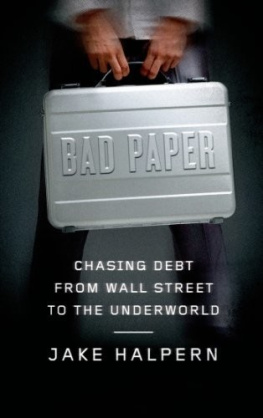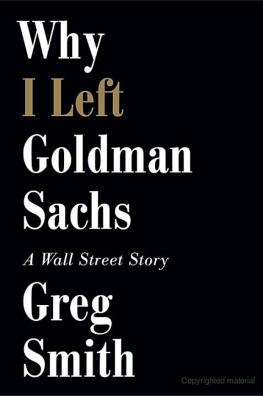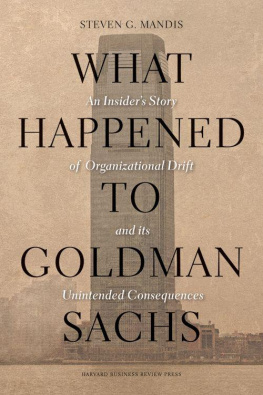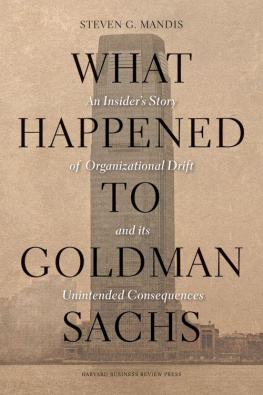Suzanne McGee - Chasing Goldman Sachs: How the Masters of the Universe Melted Wall Street Down... And Why Theyll Take Us to the Brink Again
Here you can read online Suzanne McGee - Chasing Goldman Sachs: How the Masters of the Universe Melted Wall Street Down... And Why Theyll Take Us to the Brink Again full text of the book (entire story) in english for free. Download pdf and epub, get meaning, cover and reviews about this ebook. year: 2011, publisher: Crown Business, genre: Romance novel. Description of the work, (preface) as well as reviews are available. Best literature library LitArk.com created for fans of good reading and offers a wide selection of genres:
Romance novel
Science fiction
Adventure
Detective
Science
History
Home and family
Prose
Art
Politics
Computer
Non-fiction
Religion
Business
Children
Humor
Choose a favorite category and find really read worthwhile books. Enjoy immersion in the world of imagination, feel the emotions of the characters or learn something new for yourself, make an fascinating discovery.

- Book:Chasing Goldman Sachs: How the Masters of the Universe Melted Wall Street Down... And Why Theyll Take Us to the Brink Again
- Author:
- Publisher:Crown Business
- Genre:
- Year:2011
- Rating:4 / 5
- Favourites:Add to favourites
- Your mark:
- 80
- 1
- 2
- 3
- 4
- 5
Chasing Goldman Sachs: How the Masters of the Universe Melted Wall Street Down... And Why Theyll Take Us to the Brink Again: summary, description and annotation
We offer to read an annotation, description, summary or preface (depends on what the author of the book "Chasing Goldman Sachs: How the Masters of the Universe Melted Wall Street Down... And Why Theyll Take Us to the Brink Again" wrote himself). If you haven't found the necessary information about the book — write in the comments, we will try to find it.
Suzanne McGee: author's other books
Who wrote Chasing Goldman Sachs: How the Masters of the Universe Melted Wall Street Down... And Why Theyll Take Us to the Brink Again? Find out the surname, the name of the author of the book and a list of all author's works by series.
Chasing Goldman Sachs: How the Masters of the Universe Melted Wall Street Down... And Why Theyll Take Us to the Brink Again — read online for free the complete book (whole text) full work
Below is the text of the book, divided by pages. System saving the place of the last page read, allows you to conveniently read the book "Chasing Goldman Sachs: How the Masters of the Universe Melted Wall Street Down... And Why Theyll Take Us to the Brink Again" online for free, without having to search again every time where you left off. Put a bookmark, and you can go to the page where you finished reading at any time.
Font size:
Interval:
Bookmark:
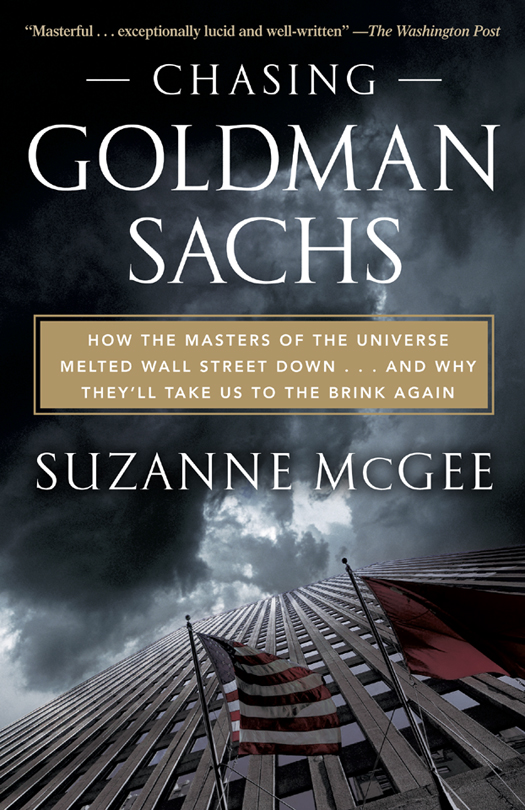
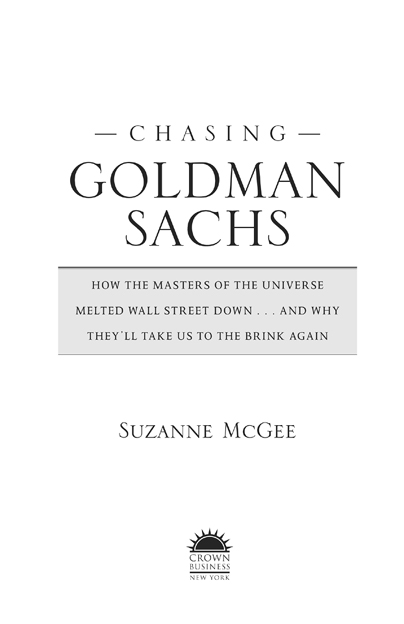
Copyright 2010 by Suzanne McGee
All rights reserved.
Published in the United States by Crown Business, an imprint of the Crown Publishing Group, a division of Random House, Inc., New York.
www.crownpublishing.com
CROWN BUSINESS is a trademark and CROWN and the Rising Sun colophon are registered trademarks of Random House, Inc.
Originally published in slightly different form in hardcover in the United States by Crown Business, an imprint of the Crown Publishing Group, a division of Random House, Inc., New York, in 2010.
Library of Congress Cataloging-in-Publication Data
McGee, Suzanne.
Chasing Goldman Sachs/Suzanne McGee.
p. cm.
1. Goldman, Sachs & Co. 2. Investment bankingUnited StatesHistory21st century. 3. Financial crisesUnited StatesHistory21st century. 4. FinanceUnited StatesHistory21st century. I. Title.
HG4930.5.M38 2010
332.660973dc22 2009053440
eISBN: 978-0-307-46012-7
Cover design by Pete Garceau
Cover photographs: Reuters/Landov (building); Getty Images (sky)
v3.1
In memory of my grandfather
James R. Burchell
Dancing to the Music
Greed, Recklessness, and Negligence: The Toxic Brew
The New Face of Wall Street
W e think were number one, but well leave that for others to decide. Back in 1983, when John Whitehead, then cochairman of Goldman Sachs & Co. made that statement to a reporter from New York magazine, the investment bank was already well on the way to becoming one of Wall Streets iconic firms. Its bankers proclaimed that they were long-term greedy; the denizens of Goldman werent the type, they declared regally, to try to capture every fraction of a penny of fees and profits, particularly if there was even a question that they might be doing so at the expense of a client relationship. Goldman Sachs even felt itself to be above some businessesno advising hostile bidders on takeover strategies, for instance; that was far too messy. Then there were some potential clients that a Goldman Sachs banker didnt want to be seen lunching with, much less transacting business with. Goldmans clients were the crme de la crme; preserving the firms name and reputation by choosing who to deal with and what deals to do was more critical than grabbing at an extra few thousand dollars in fees.
Occasionally, something unpleasant would happen to remind Goldman bankers of the solid business reasons behind those lofty principles, such as the firms brief but damaging relationship with Robert Maxwell. Many Goldman partners had felt skittish about accepting the media tycoon as a client; his checkered past included his being dubbed by a British government inquiry as not a person who can be relied on to exercise proper stewardship of a public company. But the allure of earning big fees overrode those concernsthat is, until Maxwell vanished off his yacht into the sea near the Canary Islands and a new investigation revealed that he had looted a billion pounds from his employees pension funds. British regulators hit Goldman with a fine for its role in the fiasco in 1993; the size of the fine was somewhat less important than the public humiliation, however. Partners vowed that never again would Goldman Sachs be named and shamed in such a manner.
And yet, in the summer of 2010, Robert Khuzami, head of the enforcement division of the Securities and Exchange Commission, stood triumphantly in front of a group of reporters and an array of television cameras broadcasting his words globally. He announced that Goldman Sachs had agreed to pay a fine of $550 millionthe largest penalty the SEC had ever imposed on a Wall Street firmto settle a civil fraud case the agency had filed only months earlier. But Khuzami and the SEC had won more than their $300 million share of that settlement: Goldman had agreed to acknowledge publicly that the fundamental basis of the agencys lawsuit was accurate. Goldman had failed to live up to its own standards and disclose everything that German bank IKB might have wanted to know about the mortgage securities deal, dubbed Abacus, that lay at the heart of the suit. Specifically, the SEC had claimed Goldman hadnt fully explained to IKB and other potential investors buying the Abacus package of synthetic mortgage-based securities that hedge fund manager John Paulson had played a key role selecting the specific securities in that transactionindeed, that the deal was being done at his initiative because he wanted to find a way to profit from what he expected would be a big decline in the value of the securities he chose. Thats precisely what happened: Paulson walked away a billion dollars richer, while IKB became one of the first financial institutions to fall victim to the global financial crisis and require a bailout.
Goldman Sachs, the envy of Wall Street, now found itself under scrutiny for all the wrong reasons. Instead of its peers and rivals trying to figure out what it was doing to earn the astonishing rates of return it delivered like clockwork to its investors, regulators and legislators were putting its business under a microscope. To insiders, it seemed as if everything for which Goldman was once famous and laudedits creativity in devising and structuring new products; its risk management prowess; the market insight displayed by traders deploying the firms own capital to generate returns; the firms ability to develop relationships with power players in Washington as well as on Wall Streetnow rendered it infamous. Suddenly, everyone was asking what Goldman Sachs had done to earn the gargantuan profits in recent years; profits that had left other Wall Street CEOs green-eyed with envy and fuming at their own inability to measure up.
But this bookconceived in early 2008, as Bear Stearns collapsed and Wall Street waited, holding its breath, for the next shoe to fallis not the story of the transformation of Goldman Sachs from Wall Streets most envied to its most reviled power. Rather, its the tale of the ways in which Goldman and the other Wall Street firms that sought to emulate its success underwent a fundamental transformation, and the impact of those changes for Wall Street, its clients, and the financial system as a whole. That transformationwhich led to Wall Street being run solely in the interests of Wall Street entities themselves, with clients now viewed as counterpartiespaved the way for the financial crisis whose ripple effects continue to reverberate on both Wall Street and Main Street. For the latterindeed, for most of usWall Streets value lies in its role as a financial utility or intermediary. But as the financial results of Goldman and its rivals demonstrated all too clearly, thats not where the profit lay. And ever-bigger profits were what Wall Streets own investorsthe shareholders who bought stock in Goldman Sachs, Merrill Lynch, Lehman Brothers, and other firmsdemanded, loud and clear.
The SECs fraud lawsuit against Goldman Sachs simply made public what many Wall Street insiders had long known: clients need to be able to look out for themselves. Wall Street firms are dealing cards from the bottom of the deck to their friends, while saving the low-value cards for other clients. In case there was any doubt of what Goldman bankers really thought of the deals they were taking to their clients, investigators rapidly made public a series of embarrassing e-mails and other documents. In one, top Goldman banker Tom Montag wrote of another mortgage-backed securities transactionTimberwolfthat it was one shitty deal. Certainly by the time John Paulson came knocking on its door, Goldman knew that being long subprime real estate in the spring of 2007 was likely to be a risky bet for anyone agreeing to take the other side of the trade that Paulson wanted to do; after all, the firm was pushing its team to unload their own exposure to others as rapidly as possible. In an e-mail to a friend, Fabrice Tourre, the banker who structured the deal (and who has not yet been able to settle the SECs charges against him) wrote of the CDO transactions he was crafting, the whole business is about to collapse any time now Only potential survivor, the fabulous Fab! In another e-mail, the head of Goldmans structured products correlation trading desk warned Tourre that the cdo biz is dead and that we dont have a lot of time left. None of that gave Goldman Sachs bankers a reason to stop, it seems. Even Bear Stearns had turned away John Paulson, concerned at the ethical implications of allowing a hedge fund manager to choose which securities he would bet against and thus which securities Bear would have had to coax a client to buy outright.
Font size:
Interval:
Bookmark:
Similar books «Chasing Goldman Sachs: How the Masters of the Universe Melted Wall Street Down... And Why Theyll Take Us to the Brink Again»
Look at similar books to Chasing Goldman Sachs: How the Masters of the Universe Melted Wall Street Down... And Why Theyll Take Us to the Brink Again. We have selected literature similar in name and meaning in the hope of providing readers with more options to find new, interesting, not yet read works.
Discussion, reviews of the book Chasing Goldman Sachs: How the Masters of the Universe Melted Wall Street Down... And Why Theyll Take Us to the Brink Again and just readers' own opinions. Leave your comments, write what you think about the work, its meaning or the main characters. Specify what exactly you liked and what you didn't like, and why you think so.


